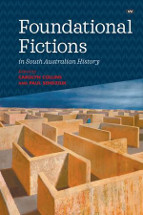Foundational fictions in South Australian history edited by Carolyn Collins and Paul Sendziuk

Wakefield Press, 2018. ISBN 9781743056066
(Age: Senior secondary - Adult) Recommended. Foundational
fictions investigates the myths that South Australians hold
dear about their state. Is it really true that South Australia was a
more enlightened settlement free of the 'convict stain'? Were the SA
settlers kinder to the Aboriginal inhabitants? Did the settlement
live up to the ideals of the Letters Patent and the Proclamation at
the old gum tree? Was SA established according to principles that
set it apart from the other states? Or is it all just beautiful
lies?
As the famous quote goes, 'history is written by the victors'. This
collection of essays examines many of the commonly held beliefs
about the history of South Australia. All South Australians would
like to believe the good stories about their ancestors, the myths
that have been passed on. Some do draw on original facts, but many
have been embellished or even completely reworked to cover over the
things we would prefer not to examine too closely.
Most interesting reading is author Lucy Treloar's response to Inge
Clendinnen's 2006 critique of Kate Grenville's novel 'The secret
river'. Treloar posits that history is greater than just the facts.
Historical fiction may offer an emotional truth that allows people
to enter into the experience of others, ponder what they felt, and
consider how they may have acted in their place. There is a place
for both - the historian allows us to examine the records of past
events, the facts, the snippets in newspapers and diaries; the
historical fiction writer allows us to enter that world and
reimagine it for ourselves.
Another writer, Jane Lydon, researching the record of bushman George
Hamilton, examines how even writers of the past era may change their
world view over time and reinvent or embellish their own records of
the past.
These are all very interesting questions for the student of history
to ponder. Foundational fictions brings together some key
(mis)conceptions about South Australia and allows the reader to
reinvestigate the past record and query just who makes history, and
how history is passed down to successive generations. This book
would be a really useful resource for developing students'
understanding of the historical concepts proposed by the Australian
history curriculum: 'evidence, continuity and change, cause and
effect, significance, perspectives, empathy and contestability'.
Helen Eddy